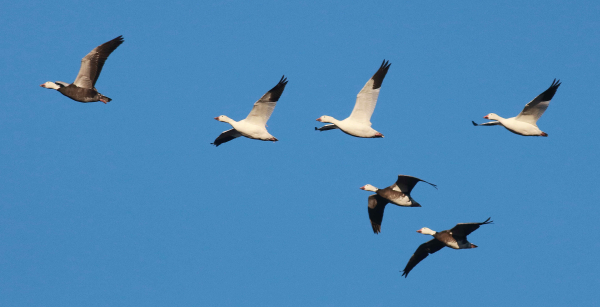
Most fall migrants utilize weather fronts with northerly wind to make long-distance flights (white and blue morph Snow Geese photographed by Paul Konrad).
|
August is considered the start of fall migration for many birds, including species of songbirds, swallows, flycatchers, raptors, and shorebirds. Although many Arctic-nesting shorebirds begin migrating south during July, even more appear in southern Canada and the United States during August, and once the southbound trend begins its exciting to monitor the progress as migration continues through November, and even December. To improve your fall migration observations, an understanding of how weather including wind direction can make a big difference.
Fall migration is an exciting time for birders, with migrants on the move, potentially transforming your favorite birding site from static to dynamic overnight, with a suite of new species to identify, count, observe, and photograph. Some of our best birding days center on being at the right place at the right time. For many birders this is mere happenstance; but you can more reliably predict bird migrations with a basic understanding of birds and weather.
Day or Night Flights?
Relative to migrations, birds can be divided into 2 basic groups: diurnal and nocturnal migrants. Soaring birds that rely on thermals to generate lift migrate during the day, such as raptors, cranes, and White Pelicans, whereas most songbirds that make long-distance migrations, for example warblers, thrushes, and sparrows migrate at night – or at least they initiate their flights under the cover of darkness! Relatively few species migrate during both day and night.
Diurnal migration can be spectacular to watch during fall, and birders traditionally gather at locations where weather and geography concentrate migrants, most notably along ridges and coastlines, including peninsulas with a southerly orientation. Nocturnal migration is more challenging to understand and experience, but our understanding of that phenomenon is rapidly advancing.
Migration Weather
The numbers of birds migrating depends on the weather, with many birds waiting until conditions are favorable before initiating migratory flights. A typical fall cold front creates favorable conditions for migration with dry cool air, usually with a northerly wind direction. These conditions can last for days, but usually the migration is most intense the day immediately following the cold front. That’s the day you’re looking for; the day to time your birding!
Most birders encounter nocturnal migrants the morning after a migration flight, when birds make landfall in appropriate habitat, conspicuously searching for suitable foods, fresh water, and cover or open areas where they can rest in preparation for their next flight. Depending on weather conditions and the availability of food, water, and cover, birds will remain in an area for a few days to a week before departing on another migratory flight – when the weather and wind are right.
August is a good time to start planning fall migration trips to take advantage of concentrations of birds you would like to see, or that you appreciate seeing each fall. It may be a regional hawkwatch site, or a lake that attracts concentrations cranes, geese, and ducks along with a variety of shorebirds, wading birds, and waterbirds. Some raptor count sites also provide excellent songbird migration viewing, and seabird count sites provide migration thrills for many birders. Fall migration is upon us; where will you concentrate your birding hours this fall?
For more information about birding strategies during fall migration, and finding a fall migration hotspot, you can refer to an informative eBird article that provided the basis for this article and some basics to consider including weather and landforms at https://ebird.org/news/fall-birding-basics/